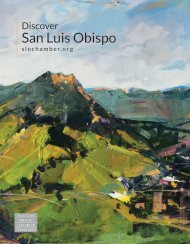You also want an ePaper? Increase the reach of your titles
YUMPU automatically turns print PDFs into web optimized ePapers that Google loves.
Just who was Saint Louis, and<br />
what did he do to get<br />
such a special place<br />
named after him?<br />
Born some 736 years ago<br />
in Brignoles, France,<br />
prior to his sainthood,<br />
the young Louis was<br />
a military cadet of the<br />
Royal French “House<br />
of Anjou,” which until<br />
it became defunct<br />
in 1435, ruled much<br />
of Southern Europe.<br />
At some point during<br />
Louis’ childhood, his<br />
father was named<br />
the “King of Naples,”<br />
because of his<br />
personal relationship<br />
with a secretary to the<br />
King of France.<br />
The Way It Was<br />
Saint Louis, the Bishop<br />
During one of the many feudal wars at the<br />
time, Louis’ father was taken prisoner in<br />
Italy, but he was able to obtain his freedom<br />
by offering his three sons as hostages<br />
[Gee… thanks, dad!]. So, Louis and his two<br />
brothers were hauled off to enemy territory<br />
in Barcelona, Spain and placed under the<br />
supervision of Franciscan friars who cared for<br />
the boys and educated them over a period<br />
of seven years.<br />
At twenty-one years old, when his older<br />
brother died in 1295, Louis became the heir<br />
to his father’s throne. It was the same year<br />
that he was freed by the friars. So, you would<br />
imagine the young prince would spend his life<br />
in-waiting, enjoying the spoils of royalty and<br />
wealth, right? Well, not quite…<br />
When presented with the choice, Louis<br />
elected to travel to Rome and announce<br />
that he would take the Franciscan vows of<br />
poverty, chastity, and obedience. He then<br />
forfeited his royal inheritance and claims to<br />
the throne to his youngest brother.<br />
Despite Louis’ desire to live a simple life in a<br />
monastery, his father’s political connections<br />
kept pulling him back into governance and<br />
the secular world. And, at the age of 22, the<br />
young Louis was appointed to the enormously<br />
important leadership position as “Bishop of<br />
Toulouse.” Although he continued to<br />
impress the Church with his dedication and<br />
willingness to walk away from vast<br />
wealth, it was the fact that his uncle,<br />
Alphonse, the brother of his father,<br />
had recently been installed as<br />
the “Count of Toulouse,” but<br />
died suddenly without a son.<br />
As a result, the position of<br />
“Bishop of Toulouse” was<br />
appointed to his nephew,<br />
Louis. It was now his job<br />
to govern the affairs of the<br />
region.<br />
Historical accounts of the<br />
time indicate that young<br />
Louis was an extremely<br />
popular and magnanimous<br />
leader, always putting the<br />
needs of others before his<br />
own. Although “mildmannered”<br />
he developed a<br />
reputation for actively serving<br />
the poor, feeding the hungry, and ignoring his<br />
own well-being. In fact, he worked so hard<br />
that just six months into his role as Bishop, he<br />
became so exhausted by his efforts that he<br />
was no longer able to function. So he quit.<br />
Just a few months later, Louis died at the age<br />
of 23. Today, it is speculated that the cause<br />
of death was actually typhoid fever that was<br />
probably brought on by his exhaustion and<br />
overexposure to his many ailing subjects. The<br />
young bishop had literally worked himself to<br />
death.<br />
After his passing Louis was never widely<br />
celebrated by the Catholic Church, but the<br />
Franciscans continued to embrace him and<br />
lobbied for his sainthood. They eventually<br />
won over Pope John XXII and Louis became<br />
Saint Louis. The Franciscans further honored<br />
him by creating a holiday in their calendar<br />
and moved his relics (essentially, his personal<br />
items) to Valencia, Spain where he was also<br />
made a patron saint. The unique bond that<br />
Saint Louis formed at a young age with the<br />
Franciscans was never forgotten. So, when<br />
Father Junipero Serra passed through this<br />
beautiful part of “Alta California” (the name<br />
the Spanish had given to lands North of<br />
Mexico) in 1772, he was inspired to name<br />
it “San Luis Obispo” which is Spanish for<br />
“Saint Louis, the Bishop.” <strong>SLO</strong> <strong>LIFE</strong><br />
Know a bit of history? Go to slolifemagazine.com and share your story.<br />
10 | slo life magazine<br />
10 | slo life MagaZine


















